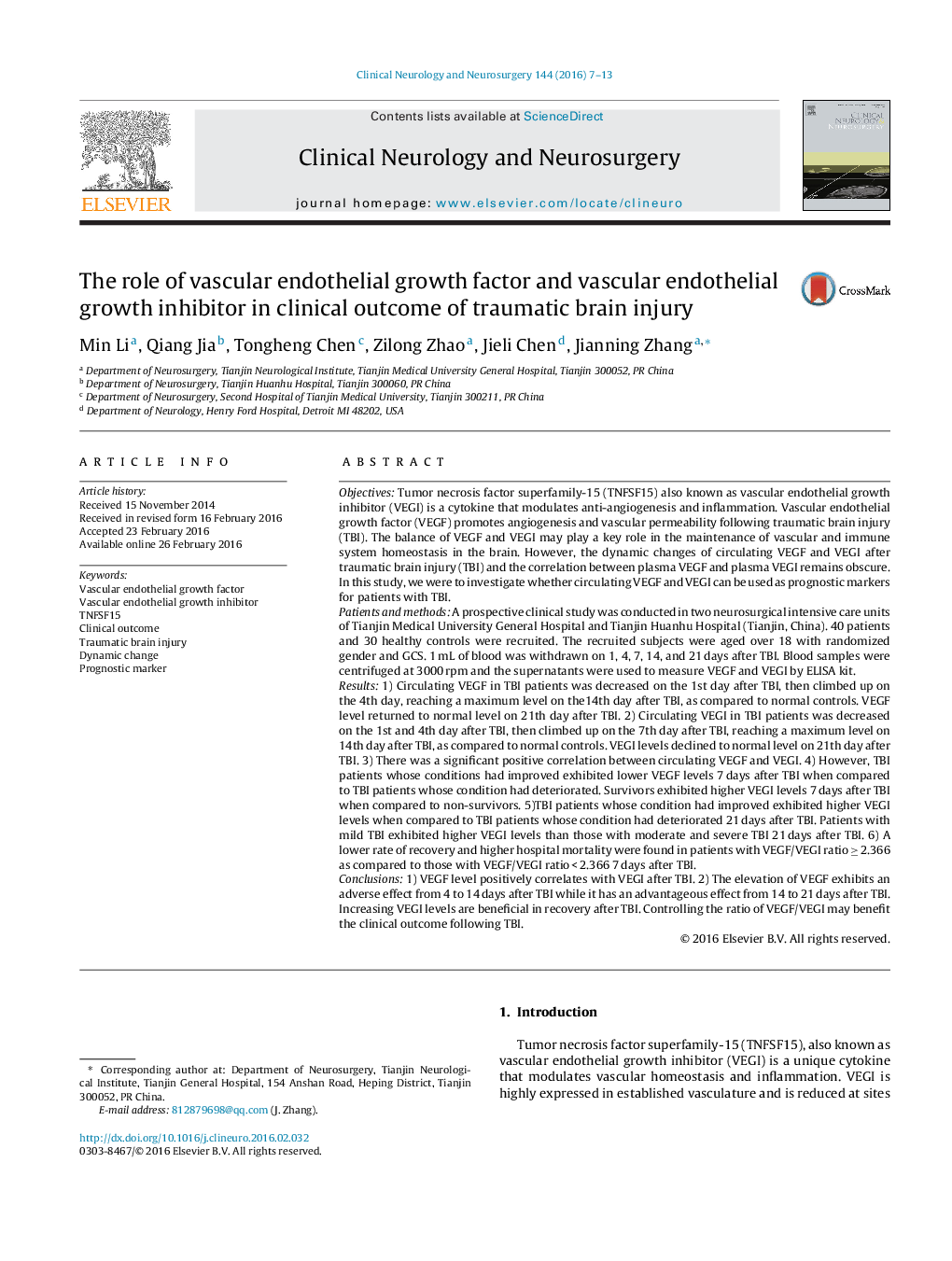| کد مقاله | کد نشریه | سال انتشار | مقاله انگلیسی | نسخه تمام متن |
|---|---|---|---|---|
| 3039482 | 1579678 | 2016 | 7 صفحه PDF | دانلود رایگان |
• Circulating VEGF in TBI patients reached climax on the14th day after TBI.
• Circulating VEGI in TBI patients reached climax on the14th day after TBI.
• Positive correlation was found between VEGF and VEGI on day 1, 4, 7 and 14 after TBI.
• VEGF and VEGI concentrations after TBI is correlated with the clinical outcome.
• A VEGF/VEGI ratio of 2.366 on day 7 is recommended as the prognostic value for TBI.
ObjectivesTumor necrosis factor superfamily-15 (TNFSF15) also known as vascular endothelial growth inhibitor (VEGI) is a cytokine that modulates anti-angiogenesis and inflammation. Vascular endothelial growth factor (VEGF) promotes angiogenesis and vascular permeability following traumatic brain injury (TBI). The balance of VEGF and VEGI may play a key role in the maintenance of vascular and immune system homeostasis in the brain. However, the dynamic changes of circulating VEGF and VEGI after traumatic brain injury (TBI) and the correlation between plasma VEGF and plasma VEGI remains obscure. In this study, we were to investigate whether circulating VEGF and VEGI can be used as prognostic markers for patients with TBI.Patients and methodsA prospective clinical study was conducted in two neurosurgical intensive care units of Tianjin Medical University General Hospital and Tianjin Huanhu Hospital (Tianjin, China). 40 patients and 30 healthy controls were recruited. The recruited subjects were aged over 18 with randomized gender and GCS. 1 mL of blood was withdrawn on 1, 4, 7, 14, and 21 days after TBI. Blood samples were centrifuged at 3000 rpm and the supernatants were used to measure VEGF and VEGI by ELISA kit.Results1) Circulating VEGF in TBI patients was decreased on the 1st day after TBI, then climbed up on the 4th day, reaching a maximum level on the14th day after TBI, as compared to normal controls. VEGF level returned to normal level on 21th day after TBI. 2) Circulating VEGI in TBI patients was decreased on the 1st and 4th day after TBI, then climbed up on the 7th day after TBI, reaching a maximum level on 14th day after TBI, as compared to normal controls. VEGI levels declined to normal level on 21th day after TBI. 3) There was a significant positive correlation between circulating VEGF and VEGI. 4) However, TBI patients whose conditions had improved exhibited lower VEGF levels 7 days after TBI when compared to TBI patients whose condition had deteriorated. Survivors exhibited higher VEGI levels 7 days after TBI when compared to non-survivors. 5)TBI patients whose condition had improved exhibited higher VEGI levels when compared to TBI patients whose condition had deteriorated 21 days after TBI. Patients with mild TBI exhibited higher VEGI levels than those with moderate and severe TBI 21 days after TBI. 6) A lower rate of recovery and higher hospital mortality were found in patients with VEGF/VEGI ratio ≥ 2.366 as compared to those with VEGF/VEGI ratio < 2.366 7 days after TBI.Conclusions1) VEGF level positively correlates with VEGI after TBI. 2) The elevation of VEGF exhibits an adverse effect from 4 to 14 days after TBI while it has an advantageous effect from 14 to 21 days after TBI. Increasing VEGI levels are beneficial in recovery after TBI. Controlling the ratio of VEGF/VEGI may benefit the clinical outcome following TBI.
Journal: Clinical Neurology and Neurosurgery - Volume 144, May 2016, Pages 7–13
